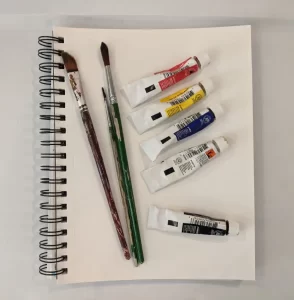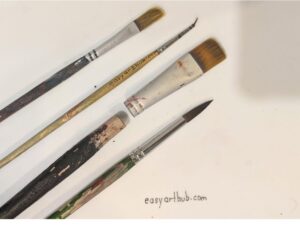If you’re a beginner artist, you might be wondering if sketching is a requirement before painting. In this blog post, we will explore the benefits of sketching, when to skip it, ways to sketch and the alternatives.
Sketching is a valuable tool for acrylic painting, but it is not a requirement. It serves as a preliminary outline of the composition while experimenting and conceptualizing before painting. Preliminary outlines for painting can also be created using alternative techniques such as grid scale, tracing, and stenciling.

~This post contains affiliate links.
What is Sketching?
Sketching, when done prior to painting, refers to the process of creating a preliminary drawing or outline on paper or canvas before starting to paint. The sketch serves as a blueprint or guide for the final painting and helps the artist to plan out their composition, proportion, and design elements.
There are lots of types and ways to categorize sketching but the main focus of this blog post will be “Direct Sketching”.
Direct Sketching
Direct sketch is a sketch made directly on the canvas or support that will be used for the final painting. It is also called underdrawing or underpainting, depending on the material used.
For simplicity’s sake, I will refer to “direct sketching” as “sketching” in this blog post. I will also call it “drawing” at times.
Note:
Sketches that are done on a separate piece of paper/sketchbook or other surfaces as a preliminary exercise will not be discussed in this post. (E.g. thumbnail sketches and reference sketches, etc.)
While these types of sketches share many similarities with ‘direct sketch’, their unique benefits and methods are worth discussing in more detail in a separate post.
Why sketch before painting?
There are good reasons why most artists start with sketching before painting. Here are the main ones:
1. It allows for experimentation.
Sketching provides the perfect opportunity to experiment with different ideas and layouts. It’s like a playground for creativity, that lets go of inhibition. This is especially important for beginners who haven’t had confidence in their painting skills yet.
Since pencil marks are less final than acrylic painting, they encourage artists to try new things without fear of wasting the canvas. One can make the necessary adjustments before starting the actual painting.
2. It improves the proportions and accuracy.
Sketching is a great way to practice and refine the accuracy and proportion of the subject being painted. It’s usually easier to get this right with an erasable medium(eg. pencil) than acrylic paint. This is most important if you are aiming for realism.
3. It maps out the composition and design.
Many artists consider sketching as the foundation of a good painting. It helps plan and organize the composition. It allows the artist to see the painting as a whole, and to make changes that might not be apparent when working on the details of the final painting.

When to skip sketching?
Despite all its benefits, one might skip sketching because of the following reasons:
1. To encourage “free-flow” styles.
If you aim for a spontaneous, free-flow style like abstract, you probably won’t need any outline.
For some, having an outline or sketch or outline can even be limiting. This can result in less dynamic and less interesting paintings.
2. When one has done it a lot of times before.
Depending on the complexity of the project, some experienced artists may skip the drawing part and go straight to painting. They may still do some ‘sketch’ (aka underpainting) by using the brush.
3. To avoid pencil or eraser marks.
In some painting surfaces like paper, using pencil or charcoal can leave marks. Depending on the painting style used, these marks can be visible even after the final painting. While a typical layer of acrylic paint can easily cover the marks, it will be impossible to do so with thin diluted layers.
4. Not enough time.
Sketching takes a bit of time. For total beginners, it could take a lot of time and practice.
Some artists just go straight to painting to save time and get on the flow with their paintbrush.
2 Ways to Sketch
Now you know the pros and cons of sketching, let’s explore how it is done and the alternatives.
Free-Hand Sketch
Free-hand sketching/drawing is the most common way to add a preliminary outline before painting. It is simple to execute; you just need a pencil, a painting surface, and drawing skills.
To directly sketch on canvas before painting with acrylics:
- Choose a subject or reference material.
- Lightly sketch basic shapes, composition, and details on canvas with a pencil.
- Experiment with different compositions and perspectives.
- Erase and redraw as needed.
- Use this sketch as a guide for acrylic painting.
Light or Dark Sketch?
The intensity of the lines should be based on the opacity of the paint you will apply and the effects you would like to achieve.
If you’re sketching for a painting with bold colors and strong contrasts, you may use darker lines for a more defined sketch. On the other hand, if you’re creating a painting with softer colors and more subtle contrasts, you may use a lower intensity to create a more delicate sketch.
If you are planning to start with pale colors, avoid using charcoal or darker lines when sketching as it will create muddy colors.
For darker painting surfaces such as rocks, I use light-colored pencils. You saw an example of this in the picture of the butterfly rock painting above where I used white colored pencil.
How to learn how to draw?
Drawing/sketching is a skill that can be very helpful in creating a masterful painting. Some people have an innate talent for drawing. If you are not one of them, fear not! With deliberate practice, it’s a learnable skill.
I use free-hand drawing in most of my paintings. It’s a skill I honed in school, not in art school, but as a science student. There I learned the fine art of doodling in between snooze-inducing lectures. The laboratory classes also come in handy! We were required to illustrate every step of our experiments to document the results. That’s how I fell in love with drawing and got a science degree as a bonus. Talk about a win-win!
As you can see, there are lots of opportunities to practice drawing. From the doctor’s office to boring meetings, the possibilities are endless!
Good old library books and the internet are great resources if you’d like to hone your drawing skills. Lots of practice, of course. And make sure to show your work to get some motivation and constructive feedback. This same advice applies to acrylic painting too.
Tools
While pencil is the most common sketching tool, my favorite thing to use is colored pencils. I love that they are they usually have light-colored ones. I can choose colors to camouflage with the paint reducing the need to erase.
Other artists use watercolor pencils, charcoal, or acrylic pens depending on their style.
Paint and brush can also be used to do the preliminary sketches. This is also referred to as underpainting.
Grid-Scale
The grid technique is a helpful way for artists to create precise drawings or paintings. It’s useful for beginners or challenging subjects like portraits or still life.
It’s a simple and effective method to transfer an image from canvas reference, helping artists create accurate and detailed drawings and paintings, and improving their skills. By dividing the reference into a grid, each section can be worked on individually and accurately capture the subject, while keeping proportions correct.
.
How to Sketch using Grid System:
- Divide the reference image into a grid of equal squares.
This can be done manually using a ruler & pencil, using a pre-lined grid, a lightbox, or even semi digitally(as you will see in the next picture). - Using a ruler and pencil, draw the same grid into the painting surface. Scale the size of this grid to the size you would like for the final painting.
You can also use pre-lined transparent grid over the lightbox. - Using the reference image and the grid as a guide, draw the basic shapes of the subject on each corresponding squares on the canvas or drawing surface, focusing on proportion and placement rather than details.
- Refine the drawing as needed before you proceed with painting.

Note: I find that grid-scale method is good for large or complex painting projects. For small and simple paintings, free-hand is much more efficient.
Other ways to add an outline sketch before painting
If you are excited to paint but not yet confident with your sketching skills, there are other ways to add an outline to guide the painting process. Here are 2 of them:
Tracing
Tracing is a mechanical process that involves copying an existing image, unlike sketching which involves drawing from observation or imagination. This can be done using pencil graphite on paper/ tracing paper/ a lightbox / a projector or even a tracing app.
Tracing can be useful when adding an outline to guide the painting process. This can be helpful for beginners who still need to gain drawing skills.
Stencil
A stencil is a thin sheet of material, such as plastic or cardboard, with a design or pattern cut out of it. The cut-out areas of the stencil act as a mask, allowing paint or ink to be applied to the surface below in the shape of the design.
Stenciling is a creative way to add repeating patterns to a painting surface. By using stencils, it creates a consistent and accurate design, making it a useful tool for adding an outline or guide in preparation for painting. It is also a helpful tool for beginners who haven’t mastered drawing yet.
Conclusion
Sketching or drawing can help with painting by improving observation, form, shape understanding, hand-eye coordination, and precision. However, one can still paint without drawing and make incredible art by exploring color, texture, and brushwork. Find your own style and have fun with it!



